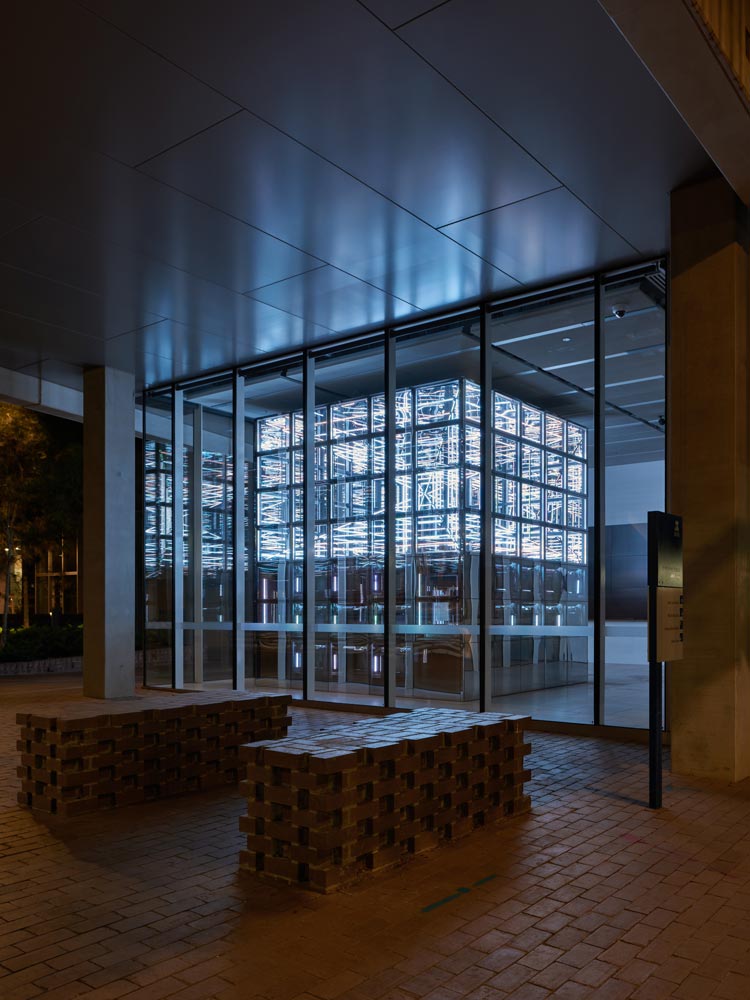Students returned to Melbourne School of Design this February to find a sleek, mirrored cube had emerged in the Andrew Lee King Fun Gallery. It forms the centrepiece of the school’s newest makerspace: the New Experimental Technology Lab (NExT Lab).
This innovative addition to MSD provides hands-on access to disruptive design technology, including virtual and augmented reality environments, a customisable lighting installation of more than 20,000 LEDs, and 32 3D printers housed within the central cube.
NExT Lab joins a suite of makerspaces at MSD, which help students bring their designs to life and gain practical experience with tools and equipment. As a learning environment, it holds regular information and training sessions to introduce students, and the wider community, to using the technology and integrating it into design projects.
The Lab has become a hive of activity since its launch. The 3D print farm has processed more than 1000 jobs, while the space has hosted introductory sessions and events in collaboration with industry, including a ‘Made in Mixed Reality’ workshop held during Melbourne Design Week.
Fabrication Team Manager Jas Johnston says it’s a place anyone can come to explore the cutting edge of technology.
“We believe designers will play a key role in shaping the future: harnessing, hacking and inventing with technology,” he says.
“To do this, we all need a place to experience, experiment and explore.”
The Lab is also a venue for workshops and events relating to new technology.
“It’s a dedicated platform for engaging with interesting researchers and industry at the forefront of technology and design,” Mr Johnston says.
It is located in a glass gallery space in a high-traffic part of the University’s Parkville campus, which informed the design of the NExT Lab cube.
“Equipment and furniture appear out of the reflective, shimmering form as needed, and then disappear to return to a clear exhibition space. This allows the space to be easily reconfigured for workshops, lectures, demonstrations, and exhibitions,” Mr Johnston says.
Master of Architecture student Nancy Samayao has worked in the Fabrication team since 2016. She now works as the lead technician in NExT Lab, assisting users to familiarise themselves with the technology on offer.
Our goal is to take away some of the mystery that might surround a new technology and make students appreciate that these are accessible forms of creation and production. Nancy Samayao, NExT Lab Lead Technician
“We share our technical knowledge and fill in the gaps so students aren’t limited because they are unfamiliar with a machine. They don’t have to be an expert to translate their work into a new format.”
Ms Samayao finds design technology exciting to work with because it is constantly changing. The early engagement with NExT Lab shows students are ready to embrace new technology in their projects.
“We’ve only had the VR and HoloLens available for students to experiment with for the past couple of months, with introductory workshops on offer for the unfamiliar, but we are already seeing the results. Students are already beginning to adopt them into projects, which is a great sign after such a short time,” she says.
“Before NExT Lab opened we had nine 3D printers available. Since opening, students have embraced the expansion and the new machines have been running at capacity, practically around the clock!”
In her own studies, Ms Samayao says she has been inspired by the work she encounters through her role with the fabrication team.

"I'm eager to continue practising a research-through-design approach; where I can look at advances in technologies in digital modelling and fabrication, and ways to incorporate interdisciplinary considerations into architectural design methods,” she says.
“I moved over to architecture from another degree because I loved the wide scope offered by architecture – far from the stereotype of ‘design a building’, there are so many facets within the discipline that can be explored. It incorporates a little bit of everything – engineering, physics, art, ecology, psychology, business and economics to name just a few! Once you’re in, each of these is an avenue that can be explored in depth.
"It’s one of the few disciplines I’ve encountered that completely embraces an interdisciplinary approach in everything.”
For more information about NExT Lab, including booking details for information sessions and events, visit the website.